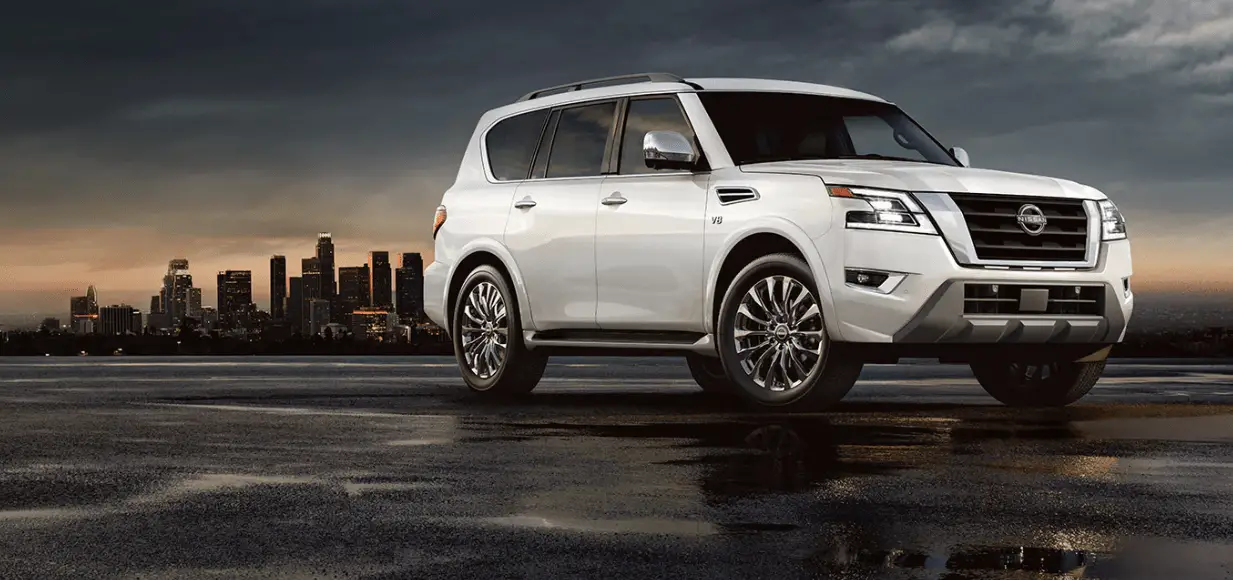Nissan ARMADA 2022 Push starting and Towing your vehicle
The 2022 Nissan Armada is a modern gem when it comes to how well cars work and how easily they can move around. It has a lot of features that are meant to make driving it as safe and easy as possible for its drivers. It may not be a good idea to use push-starting, which was common in the past, to start the Armada’s advanced engine. However, this full-size SUV is great at pulling. By being able to pull heavy loads, the 2022 Armada becomes an essential vehicle for people who are going on trips with boats, trucks, or other large items. This opening sets the stage for a look at the Armada’s abilities in both push starting and towing, with a focus on how its modern engineering makes it the most reliable and flexible car on the road.
2023 Nissan Armada Specs, Price, Features and Mileage (Brochure)
PUSH STARTING
Do not attempt to start the engine by pushing.
CAUTION
Automatic transmission models cannot be push-started or tow-started. Attempting to do so may cause transmission damage.
Three-way catalyst-equipped models should not be started by pushing since the three-way catalyst may be damaged.
Never try to start the vehicle by towing it; when the engine starts, the forward surge could cause the vehicle to collide with the tow vehicle.
IF YOUR VEHICLE OVERHEATS
CAUTION
- Do not continue to drive if your vehicle overheats. Doing so could cause engine damage or a vehicle fire.
- To avoid the danger of being scalded, never remove the radiator cap or coolant reservoir cap while the engine is still hot. When the radiator cap or coolant reservoir cap is removed, pressurized hot water will spurt out, possibly causing serious injury.
- Do not open the hood if steam is coming out.
If your vehicle is overheating (indicated by an extremely high-temperature gauge reading), or if you feel a lack of engine power, detect abnormal noise, etc., take the following steps:
- Move the vehicle safely off the road, apply the parking brake and move the shift lever to the P (Park) position. Do not stop the engine.
- Turn off the heater and air conditioner. Open all the windows, move the heater or air conditioner temperature control to maximum hot and fan control to high speed.
- If engine overheating is caused by climbing a long hill on a hot day, run the engine at a fast idle (approximately 1,500 rpm) until the temperature gauge indication returns to normal.
- Get out of the vehicle. Look and listen for steam or coolant escaping from the radiator before opening the hood.(If steam or coolant is escaping, turn off the engine.) Do not open the hood further until no steam or coolant can be seen.
- Open the engine hood.
WARNING
If steam or water is coming from the engine, stand clear to prevent getting burned. - Visually check drive belts for damage or looseness. Also, check if the cooling fan is running. The radiator hoses and radiator should not leak water. If cool-ant is leaking or the cooling fan does not run, stop the engine.
WARNING
Be careful not to allow your hands, hair, jewelry, or clothing to come into contact with, or get caught in, engine belts or the engine cooling fan. The engine cooling fan can start at any time. - After the engine cools down, check the coolant level in the reservoir tank with the engine running. Add coolant to the reservoir tank if necessary. Have your vehicle repaired. It is recommended you visit a NISSAN dealer for this service.
TOWING YOUR VEHICLE
When towing your vehicle, all State (Provincial in Canada) and local regulations for towing must be followed. Incorrect towing equipment could damage your vehicle. Towing instructions are available from a NISSAN dealer. Local service operators are familiar with the applicable laws and procedures for towing. To assure proper towing and to prevent accidental damage to your vehicle, NISSAN recommends that you have a service operator tow your vehicle. It is advisable to have the service operator carefully read the following precautions.
WARNING
- Never ride in a vehicle that is being towed.
- Never get under your vehicle after it has been lifted by a tow truck.
CAUTION
- When towing, make sure that the transmission, axles, steering system and powertrain are in working condition.
If any of these conditions apply, dollies or a flatbed tow truck must be used. - Always attach safety chains before towing.
For information about towing your vehicle behind a recreational vehicle (RV)
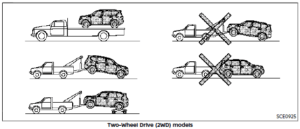
TOWING RECOMMENDED BY NISSAN
Two-wheel drive (2WD) models
NISSAN recommends that your vehicle be towed with the driving (rear) wheels off the ground or place the vehicle on a flatbed truck as illustrated.
CAUTION
- Never tow automatic transmission models with the rear wheels on the ground or four wheels on the ground (forward or backwards), as this may cause serious and expensive damage to the transmission. If it is necessary to tow the vehicle with the front wheels raised, always use towing dollies under the rear wheels.
- When towing rear-wheel drive models with the front wheels on the ground or on towing dollies: Place the ignition in the ACC or ON position, and secure the steering wheel in a straight-ahead position with a rope or similar device.

Four-wheel drive (4WD) models
NISSAN recommends that towing dollies be used when towing your vehicle or that the vehicle be placed on a flatbed truck as illustrated.
CAUTION
Never tow 4WD models with any of the wheels on the ground as this may cause serious and expensive damage to the powertrain.
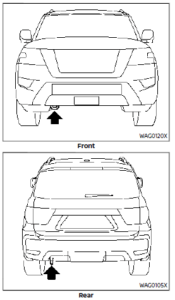
VEHICLE RECOVERY (freeing a stuck vehicle)
WARNING
- Stand clear of a stuck vehicle.
- Do not spin your tires at high speed. This could cause them to explode and result in serious injury. Parts of your vehicle could also overheat and be damaged.
Pulling a stuck vehicle
If your vehicle is stuck in the sand, snow, mud, etc., use a tow strap or other device designed specifically for vehicle recovery. Always follow the manufacturer’s instructions for the recovery device. Attach the tow strap to the towing hook.
CAUTION
- Tow chains or cables must be attached only to the main structural members of the vehicle or the towing hooks. Otherwise, the vehicle’s body will be damaged.
- Use the towing hook only to free a vehicle stuck in sand, snow, mud, etc. Never tow the vehicle for a long distance using only the towing hook.
- The towing hook is under tremendous force when used to free a stuck vehicle. Never pull the hook at an angle.
- Always pull the cable straight out from the front or rear of the vehicle.
- Pulling devices should be routed so they do not touch any part of the suspension, steering, brake or cooling systems.
- Pulling devices such as ropes or canvas straps are not recommended for use in vehicle towing or recovery.
Rocking a stuck vehicle
If your vehicle is stuck in sand, snow, mud, etc., use the following procedure:
- Turn off the Vehicle Dynamic Control (VDC) system.
- Make sure the area in front and behind the vehicle is clear of obstructions.
- Turn the steering wheel right and left to clear an area around the front tires.
- Slowly rock the vehicle forward and backward.
- Shift back and forth between R (Reverse) and D (Drive).
- Apply the accelerator as little as possible to maintain the rocking motion.
- Release the accelerator pedal before shifting between R and D.
- Do not spin the tires above 35 MPH (55 km/h).
- If the vehicle cannot be freed after a few tries, contact a professional towing service to remove the vehicle.
FOUR-WHEEL DRIVE (4WD) MANUAL SHIFTING (4WD models)
This section describes the procedure for manually shifting the vehicle into the 4WD mode (4L position) in case of an emergency.
2023 Nissan Armada Specs, Price, Features and Mileage (Brochure)
WHEN 4WD WARNING LIGHT ILLUMINATES
If the 4WD warning light illuminates while driving, there may be a malfunction in the 4WD system. Stop the vehicle and have the vehicle checked as soon as possible. It is recommended you contact a NISSAN dealer for this service.
When the vehicle is stuck on an uneven road (desert, mud, etc.) and the 4WD warning light is illuminated, be sure to place the 4WD shift switch in the 4L position. If only the rear wheels are spinning, this means that the transfer has not switched to the 4L position electrically.
If this situation occurs, contact a dealer or road assistance service for help. If immediate service is not available, perform the following procedure to switch to the 4L position manually and free the vehicle.
CAUTION
Only perform this procedure in an emergency.
If the vehicle is driven for a long period over a long distance with a component detached, foreign material such as water, sand, etc. may enter from the opening and this may cause a malfunction in the drivetrain system. After freeing a vehicle that has become stuck, it is recommended you contact a NISSAN dealer for inspection and repair.
WARNING
- Ensure your safety before performing the operations. The vehicle may move unexpectedly.
- Place the ignition switch in the OFF position, apply the parking brake and let the vehicle cool down.
- Do not perform the following procedure immediately after driving the vehicle. Parts such as exhaust components, the transmission, etc. are very hot and may cause a burn injury.
- Make sure that the parts that will be operated as well as related parts cool down before perform-ing the operation.
- Burrs or projecting portions of metal components may cause unexpected injury to your fingers or arms. Pay special attention in regard to your safety while re-moving and installing these parts. Wear work gloves and protective arm covers.
CAUTION
While removing and installing the parts, prevent the removed parts from getting dirty with water, dirt or sand. Protect the parts using a cover such as a clean cloth, etc.
OPERATING PROCEDURE
Place the ignition switch in the OFF position and apply the parking brake. Let the vehicle cool down before performing the following procedure.
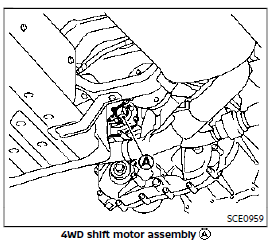
- Check that the ignition switch is in the OFF position.
CAUTION
The following procedure includes the removal of the electrical system components. Therefore, make sure that the ignition switch is in the OFF position before proceeding.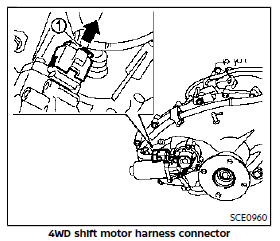
- Unlock the upper lock of the harness connector of the 4WD shift motor assembly, then remove the harness connector.
- Cover the connector to prevent it from getting dirty, and then fasten the connector to the vehicle using a suitable rope so that the connector does not contact the exhaust muffler, etc.
CAUTION
The connector must be fastened securely. Not doing so may result in damage to the connector due to interference with other parts.
- Remove the 4 bolts that secure the 4WD shift motor using the wrench that is equipped in the vehicle.
- Remove the 4WD shift motor assembly.
CAUTION
Be careful not to allow the assembly to contact water, dirt or sand.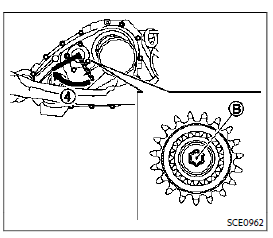
- Completely insert the wrench into the internal gear of the transfer.
- Fully turn the wrench clockwise as far as it will go. This shifts the transfer to the 4L position.
- Install the 4WD shift motor assembly. Securely tighten the 4 bolts using the wrench.
CAUTION- Do not connect the harness connector of the 4WD shift motor after the above procedure has been performed.
- The 4 bolts are tightened to temporarily install the 4WD shift motor so that water, dirt or sand does not enter inside the system. Therefore, they should only be tightened to the proper tightening torque. It is recommended you contact a NISSAN dealer for inspection and repair.
- With the 4WD system in the 4L position, free the stuck vehicle.
CAUTION
After manually shifting the vehicle to the 4L position, it is recommended you contact a NISSAN dealer for inspection and repair as soon as possible.
FAQ
Push starting, also known as bump starting or push-priming, is a method used to start a vehicle with a dead battery by physically pushing or rolling it to build up enough momentum to engage the engine and start it.
The 2022 Nissan Armada is typically not equipped for push starting, as it has a modern engine with electronic controls that require a functioning battery and ignition system to start.
If your Armada won’t start due to a dead battery, it’s recommended to use jumper cables and another vehicle with a charged battery to jump-start it.
To jump-start your Armada, you’ll need jumper cables and another vehicle with a charged battery. Connect the cables following proper safety procedures and then start your Armada.
The specific procedure for jump-starting your Armada is outlined in the vehicle’s owner’s manual. It’s essential to follow the manufacturer’s instructions carefully to avoid damage to the vehicle.
Yes, you can tow the 2022 Nissan Armada, but it’s essential to follow Nissan’s recommended towing procedures and use the appropriate equipment, like a tow dolly or a flatbed trailer.
Flat towing, also known as dinghy towing, is when a vehicle is towed with all four wheels on the ground. Some Armada models may be suitable for flat towing, but it’s essential to consult the owner’s manual for specific guidance.
The towing capacity of the 2022 Nissan Armada can vary depending on the trim level and equipment. It’s important to check your vehicle’s towing capacity in the owner’s manual.
When towing your Armada, it’s crucial to ensure that the towing equipment is properly installed, the load is within the specified weight limits, and you follow safe towing practices to prevent accidents and damage to the vehicle.
If your Armada is equipped with built-in towing features, such as trailer sway control or a towing mode, you should engage these features when towing to enhance safety and stability.
The Armada may have specific towing restrictions or limitations, especially regarding maximum weight capacities and towing speed limits. These details can be found in the owner’s manual.
Towing an Armada with all four wheels on the ground may be possible, but it depends on the specific model and equipment. Consult the owner’s manual or a Nissan dealer for guidance.
Depending on the towing method and load, you may need to make modifications or additions to your Armada, such as installing a towing hitch or using a transmission cooler. Consult the owner’s manual and a professional mechanic for recommendations.
If your Armada experiences a breakdown while towing, follow standard roadside assistance procedures, such as contacting a tow service or Nissan’s roadside assistance hotline.
The warranty coverage for towing-related issues can vary, so it’s essential to review your vehicle’s warranty information in the owner’s manual or consult your Nissan dealership for specific details.
Useful Link
View Full User Guide: Nissan ARMADA 2022 User Guide
Download Manuals: https://www.nissanusa.com/owners/ownership/manuals-guides.html
2023 Nissan Armada Specs, Price, Features and Mileage (Brochure)

